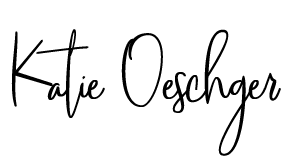Lansing GiveCamp (Design Team)
Gravity Works (Development Team)
Mary Ramsey (AZADV Stakeholder)
Ellen Kulie (AZADV Stakeholder)
Membership Growth & Retention
A bold modernization for an international zoo & aquarium professional organization that increased membership by 6% in the first month of launch.
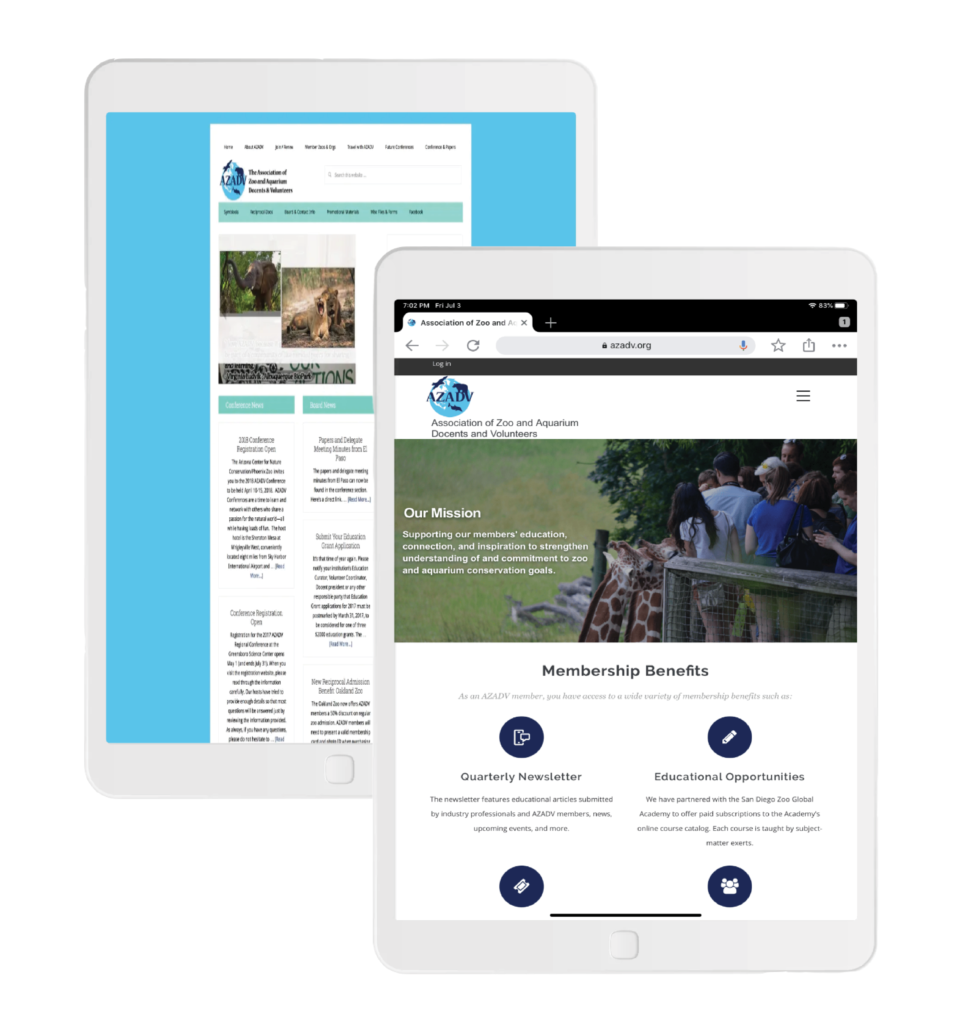
Who I Worked With
My Role
UX Research (Primary)
UI Design (Primary)
Content Design (Primary)
HTML & CSS Coding (Secondary)
Research Methods
Content Audit
Web Analytics
Competitive Analysis
Usability Testing
Focus Groups
Tools Used
Adobe Photoshop
Drupal CMS
Basecamp
The Challenge
Increase Membership
The Association of Zoo and Aquarium Docents and Volunteers (AZADV) is an international not-for-profit association who's mission is to support the connection, education, and inspiration of members to bolster zoo/aquarium conservation. The organization's membership had been dramatically decreasing over the past several years. To ensure its survival, the organization needed new ways to attract and retain members.
Our high level goals were to:
- Increase AZADV's professional credibility with a modern, professional appearance.
- Create a virtual presence that conveys the organization's purpose and values.
- Reduce the organization's paper footprint to support conservation efforts.
- Select a web development vendor and setup technological tools that can support organizational growth and expansion into the future.
Design Process
Discovery
Stakeholder Interviews
Limited by an Outdated Website
At the outset of the project, I interviewed stakeholders to establish an understanding of the goals, challenges, top priorities, and aspirations for the Association. The stakeholders who participated were longtime AZADV members that held positions on the executive board.
Key Findings
Stakeholders recognized a vibrant, modern, mobile-friendly website was no longer a luxury but a necessity for:
- Membership recruitment
- Provide valuable membership exclusives
Content Audit
Assessing the Digital Experience
To get a better understanding of the problem and stakeholder concerns, I audited the organization’s website and all communication regularly distributed to members. The old website was:
- Cluttered
- Challenging to navigate
- Not mobile-friendly
- Text-heavy / limited visuals
- Poorly organized
- Did not highlight the organization’s priorities or credibility
- Featured outdated and redundant content
- Branding was inconsistent across documents and media platforms
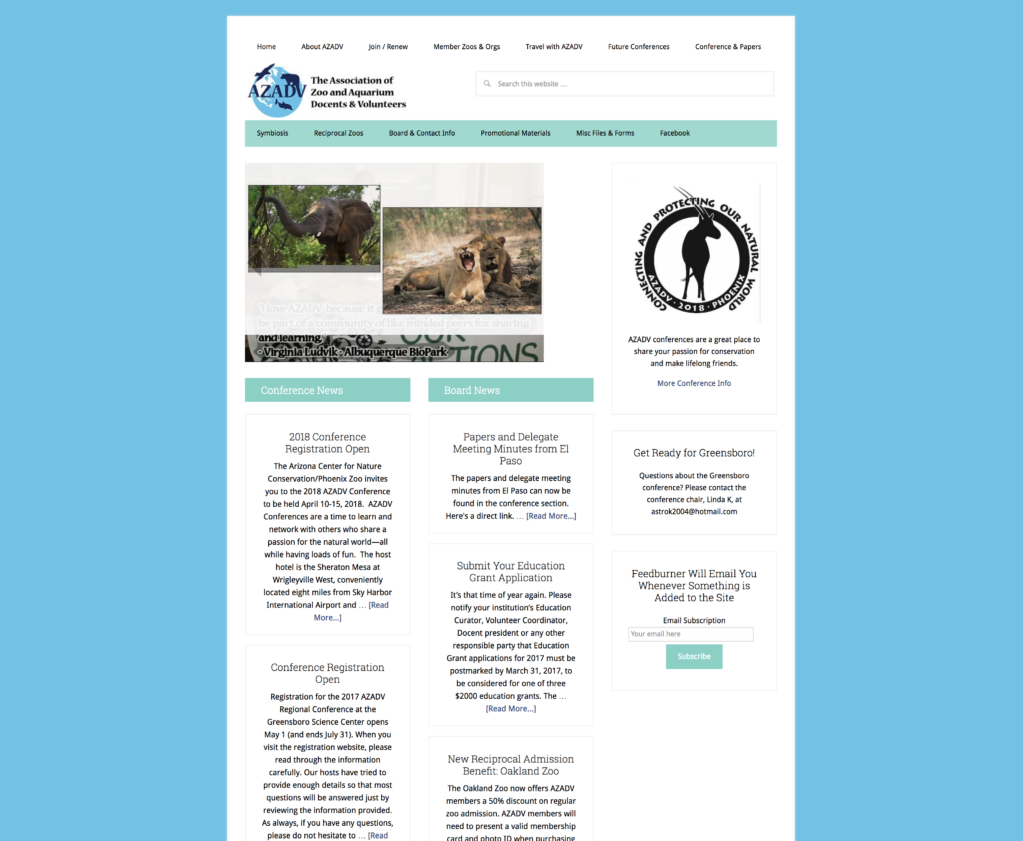
Web Analytics
User Behavior Insights
My next step was to glean insights about user behavior and motivations using the AZADV website by reviewing the website's Google Analytics. Initially trained as a behavioral scientist, I'm comfortable working with numbers, graphs, spreadsheets, statistics, and data sets. Google Analytics data was a valuable tool for this project to identify (1) how the old website was used and (2) what pre-existing web content was valuable and useful to members. The top visited webpages are listed below.
#1 Homepage
#2 Conferences
#3 Join & Renew
#4 Newsletters
Competitive Analysis
How Does AZADV Compete in the Marketplace?
I conducted a competitive analysis to compare AZADV's digital communication presence with two similar organizations, the Association of Zoos & Aquariums (AZA) and the American Association of Zoo Keepers (AAZK). I specifically investigated member benefits, notable features, and how AZADV could differentiate itself from these organizations. At the time, AZA had just launched a website redesign.
| Features | AZADV | AZA | AAZK |
|---|---|---|---|
| Password-Protected Portal on Website | |||
| Newsletter (Member Exclusive) | |||
| Reports Published Online | |||
| Online Forms | |||
| Online Forums (Member Exclusive) | |||
| Educational Resources (Member Exclusive) | |||
| Online Store | |||
| Modern Web Design | |||
| Website Easy to Navigate | |||
| Imagery Animal Focused | |||
| Partnership with the San Diego Zoo Global |
Personas
Creating Personas to Guide Design
Based on the data collected from stakeholder interviews and web analytics, I created a persona to serve as a broad representation of AZADV members. The persona was used as a means to build empathy with the users we were designing for, predict user behaviors, and to keep designs user-centered throughout the project.
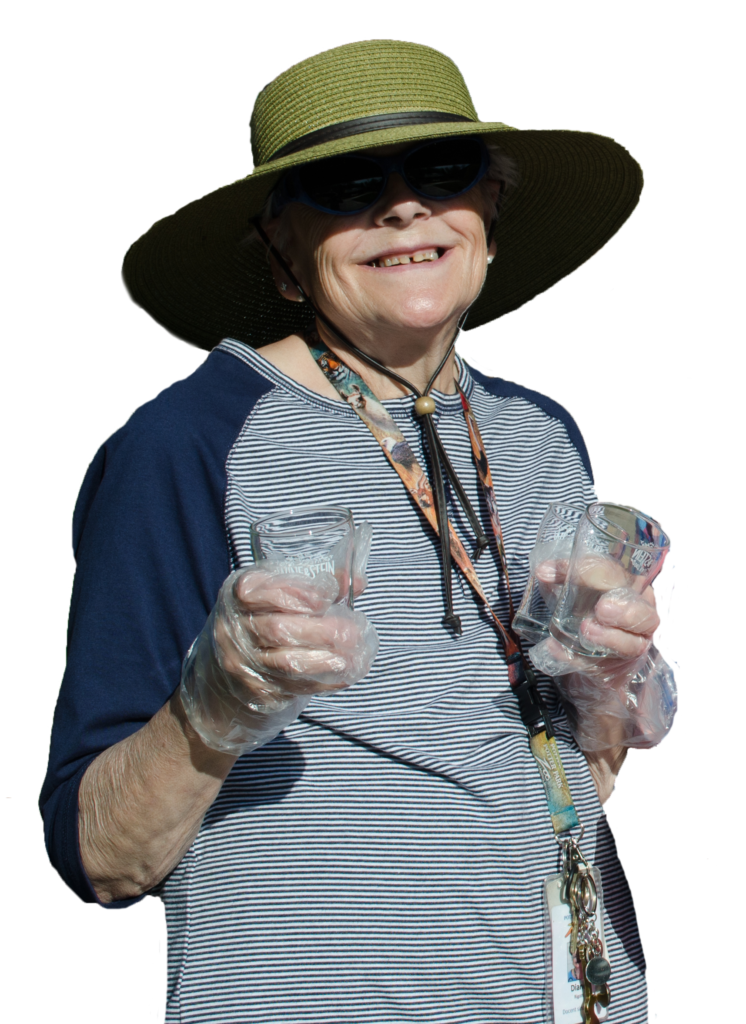
Diane Ramsey
demographics
Age: 62
Occupation: Retired School Teacher
Education: Bachelor's Degree
Marital Status: Single
Technology Use: Microsoft Office, Email, Websites, Facebook
Skill Level: Novice
Behaviors & Needs
Diane is passionate about animal conservation. She takes reusable bags to the grocery store, recycles, and is an advocate for wildlife. For example, when eating out she regularly asks to speak with the restaurant manager to encourage him/her to eliminate their use of single-use straws. Diane is actively involved in her urban community as a docent at the local zoo. At the zoo, she enjoys teaching children about animals and conservation. Diane has been a member of AZADV for 15 years.
Diane is a frequent traveler. At each travel destination, she prioritizes visiting the local zoos and aquariums. When planning a visit to another zoo or aquarium, she would like to connect with a fellow AZADV member affiliated with that facility to get advice about "what not to miss" during her visit. Diane collects pins at every zoo she visits.
Diane regularly attends the annual AZADV conference to see old friends from across the country and participate in the pre-arranged trips. She has high demands and expectations for the conference logistics and housing accommodations.
She enjoys reading the AZADV newsletter, but sometimes she struggles to open it as a PDF email attachment. Similarly, she struggles to use websites that don't follow standard design conventions. Diane doesn't like the current AZADV website because she struggles to find the information she needs.
In general, Diane isn't tech-savvy, but she is comfortable using Facebook. She is a very active member of the closed AZADV Facebook Group. She likes reading posts about species-specific conservation articles, conservation updates, and examples of what other zoos are doing. In the future, she would like more opportunities to share and discuss ideas, tips, techniques, and information with fellow AZADV members. She doesn't like to read negative comments or ethical arguments.
Diane Ramsey
demographics
Age: 62
Occupation: Retired School Teacher
Education: Bachelor's Degree
Marital Status: Single
Technology Use: Microsoft Office, Email, Websites, Facebook
Skill Level: Novice
Behaviors & Needs
Diane is passionate about animal conservation. She takes reusable bags to the grocery store, recycles, and is an advocate for wildlife. For example, when eating out she regularly asks to speak with the restaurant manager to encourage him/her to eliminate their use of single-use straws. Diane is actively involved in her urban community as a docent at the local zoo. At the zoo, she enjoys teaching children about animals and conservation. Diane has been a member of AZADV for 15 years.
Diane is a frequent traveler. At each travel destination, she prioritizes visiting the local zoos and aquariums. When planning a visit to another zoo or aquarium, she would like to connect with a fellow AZADV member affiliated with that facility to get advice about "what not to miss" during her visit. Diane collects pins at every zoo she visits.
Diane regularly attends the annual AZADV conference to see old friends from across the country and participate in the pre-arranged trips. She has high demands and expectations for the conference logistics and housing accommodations.
She enjoys reading the AZADV newsletter, but sometimes she struggles to open it as a PDF email attachment. Similarly, she struggles to use websites that don't follow standard design conventions. Diane doesn't like the current AZADV website because she struggles to find the information she needs.
In general, Diane isn't tech-savvy, but she is comfortable using Facebook. She is a very active member of the closed AZADV Facebook Group. She likes reading posts about species-specific conservation articles, conservation updates, and examples of what other zoos are doing. In the future, she would like more opportunities to share and discuss ideas, tips, techniques, and information with fellow AZADV members. She doesn't like to read negative comments or ethical arguments.
Discovery Takeaway
Prioritize a Web Redesign
Based on the data collected, numerous ideas were generated including, but not limited to, offering digital conferences, developing and implementing a brand style guide, and/or offering online educational, training modules to members.
During the Discovery Phase, I found the organization's opportunity for growth and expansion was limited by the functionality and setup of their current website. In order to offer new digital experiences to recruit and retain members, the website first needed to be redesigned.
Design & Testing
Wireframing
Planning Designs
During the vendor search process, AZADV was selected for the Lansing Givecamp, a two-day event sponsored by Gravity Works to build free web solutions for nonprofits. This was an $18,000 savings to the organization!
Before we began, I reviewed the UX research insights with the Lansing Givecamp team. We used these findings to guide our design decisions. Together with my team members, we sketched wireframes for each webpage. Wireframes were a quick, inexpensive way to explore and convey design ideas. The approved wireframes were used as guides to build the prototype.
Information Architecture
Improving Findability & Usability
Prior to the Lansing Givecamp, I developed a revised sitemap. The sitemap's content was prioritized based on data, value to members, and project objectives.
The goal was to create a well-organized, straightforward, and easy to navigate website. For example, I simplified the website's main navigation to emphasize the most important web pages. With stakeholder approval, many pages from the old website were either culled or the information consolidated to increase findability and usability. Now every page on the website is reachable in three clicks or less.
New Sitemap
Old Sitemap
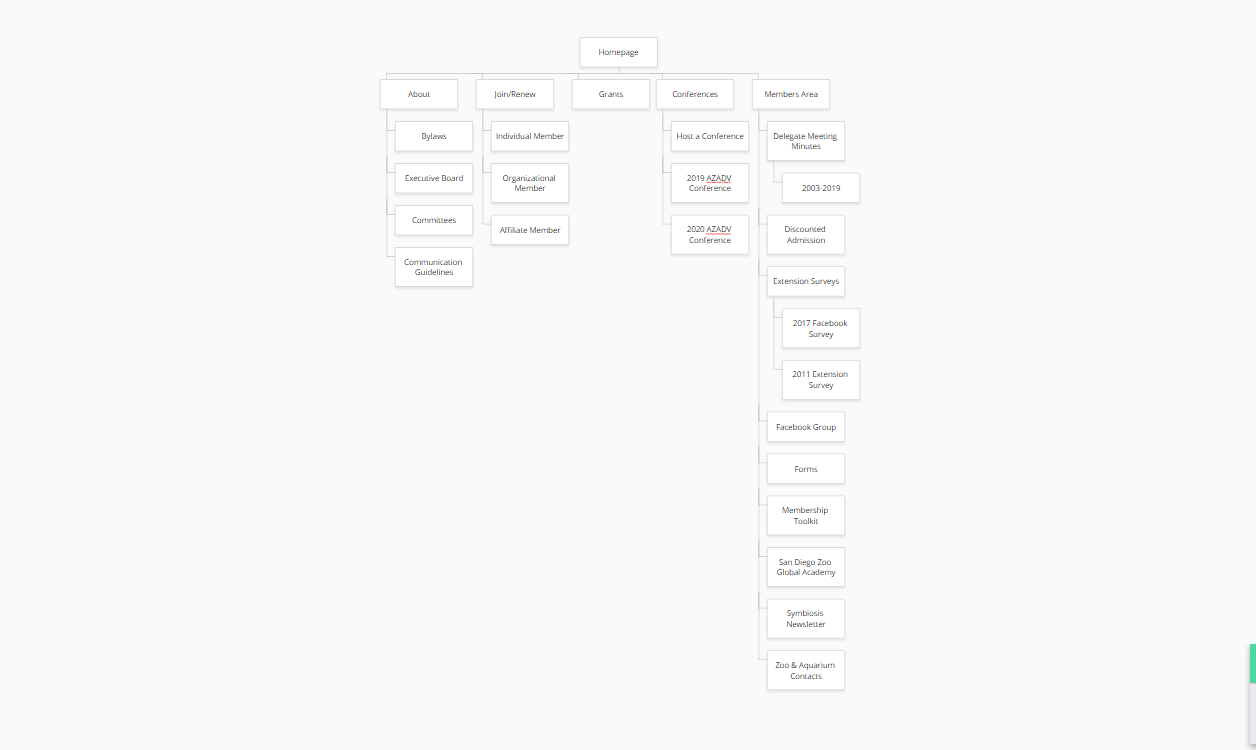
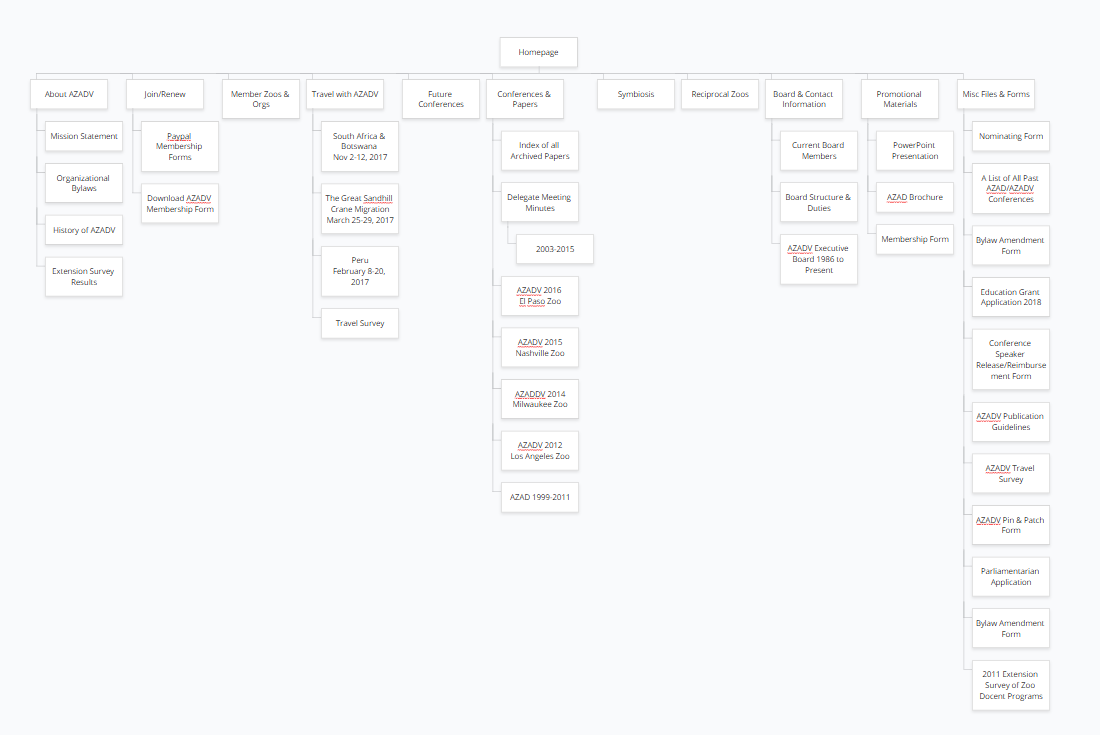
Content Design
Investing in Great Content
During the content audit, I discovered the text on AZADV's old website was outdated, very wordy, and difficult to scan quickly. For the redesign, we wanted to provide current and prospective members valuable, relevant content while also fulfilling the organization's business objectives. Great content is truly a worthwhile investment in the future.
More than 50% of the web copy was eliminated because it either offered limited value to members, didn't tell the story of the organization, or support what AZADV has to offer.
I wrote the new web copy based on content marketing strategies and how people use the web. For example:
- I wrote short and simple text that can be read quickly.
- I avoided using jargon to make the content easier for everyone to understand.
- I used a consistent brand voice to convey professionalism.
- There was a clear call-to-action to get readers to take the next step.
- Visual hierarchies were created with headers, subheaders, and lists so that content can be scanned quickly by readers.
Inaugural Brand Style Guide
A Professional New Look
During the Discovery Phase, I found inconsistent branding across member communications, including the website. The organization had a logo and several brand colors but they lacked guidelines on how to use them. I created an inaugural Brand Style Guide and supplemental brand toolkit (e.g., letterhead, slidedeck, photo gallery) to align designers and developers during the web redesign and the AZADV organization moving forward. The Brand Style Guide addressed topics such as voice and tone, logo use, fonts, colors, email signatures, and more.
The style guide and toolkit were received with great enthusiasm by the executive board.
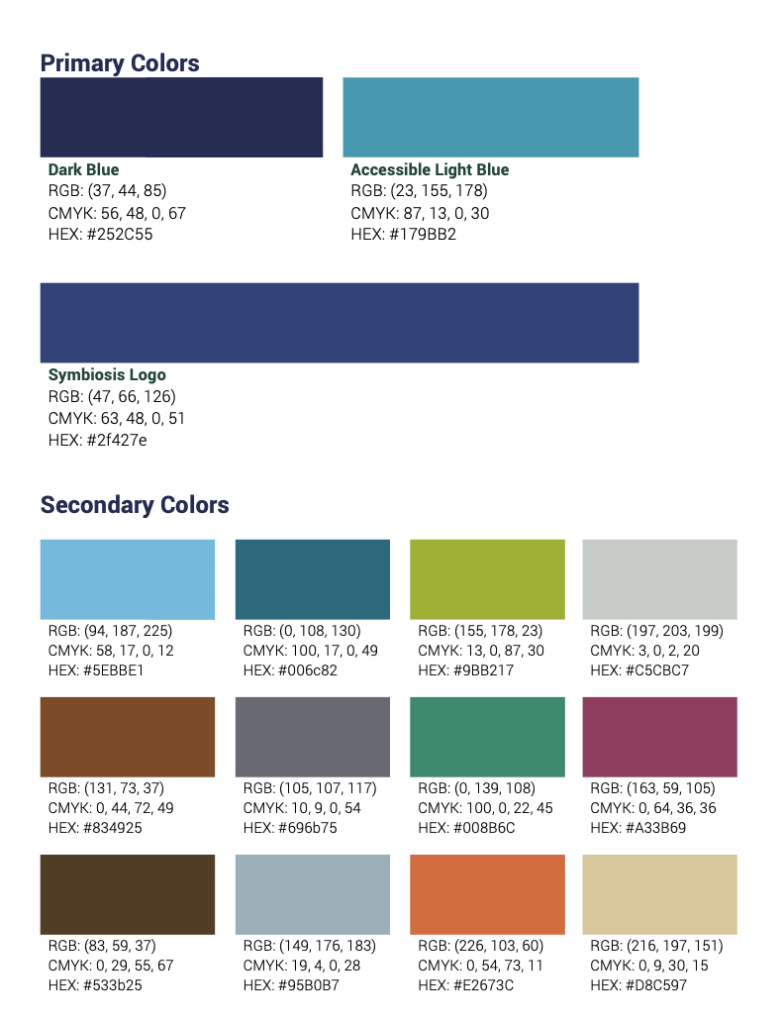
Lansing Givecamp
High-Fidelity Prototype
A Quick Build
Due to limited resources and time constraints of the two day Lansing Givecamp, our team jumped right into building a high-fidelity prototype with HTML & CSS using the Drupal Content Management System (CMS). Although I had never used Drupal, I adapted quickly to the CMS and put my coding skills to work. The prototype was used to test ideas, work through design problems, and solicit user feedback.
New Features
Password Restricted Area
The stakeholders' dream was to have a website with a "public" area for prospective members and a "members-only" area that could feature exclusive content for paid members. We made their dream come true. In the future, AZADV would like to attract more members by increasing the resources available in the members-only area.
Responsive Design
The old website was not responsive. To increase the website's usability on multiple devices, the new website was designed to be mobile and tablet-friendly.
Online Forms
A goal of the project was to reduce the organization's paper footprint to support conservation efforts. AZADV had always relied heavily on paper forms. The new website features online forms that can be submitted electronically, thus eliminating paper waste.
Zoo & Aquarium Contacts
When planning a visit to another zoo or aquarium, members wanted a mechanism to connect with a fellow AZADV member affiliated with that facility to get advice about "what not to miss" during their visit. A Zoo & Aquarium Contacts page was created in the Members Area to list an AZADV contact person for each facility.
Accessible Design
Designs were created with accessibility and usability at the forefront. For example, the light blue brand color was adjusted so that it would meet WCAG AA guidelines. The new, accessible light blue was adopted as the official light blue in the brand style guide I developed.
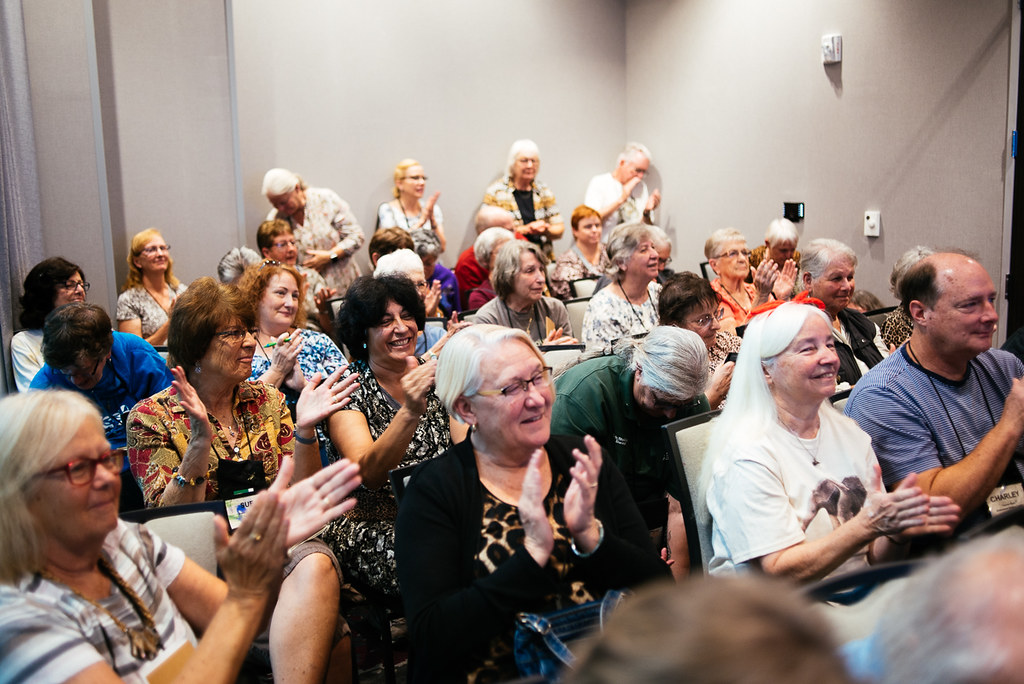
Testing: Focus Group
Soliciting User Feedback
AZADV members were recruited at the annual conference to participate in a focus group. A focus group was a quick, time-saving method to evaluate members' reaction to the new design and solicit their feedback.
Overall, the feedback was positive and enthusiastic. Only minor design modifications were suggested. For example, There was a group consensus to change the navigation terminology from 'Membership' to 'Join/Renew.' The focus group generated many ideas for future web enhancements that will be explored in more depth in the future.
Testing: Guerilla Usability Testing
Into the Hands of Users
A small sample of current and prospective AZADV members participated in usability testing. Usability testing gave users the opportunity to directly interact with the website before it officially went live. Data collected was used to further refine minor errors in the design and usability of the website.
Feedback from usability testers validated our design goals. For example one person said, "I very much like the fact that it's all set up in such a way that visitors can glance through, or get more detailed info if they so desire."
Conclusion
1
2
3
1
2
3
1312 MEMBERS
November 2019
New Website
December 2019
1388 MEMBERS
January 2020
The website launched in December 2019. Despite ample preparation, the project was too ambitious for the two-day Lansing GiveCamp. Since the project was pro bono with Gravity Works, it took longer for the developers to finish up the database functionality of the password-restricted member area. Feedback from both the AZADV executive board and members was overwhelmingly positive.
Feedback from Members
After the website went live, I received lots of feedback from members such as, "This is outstanding! Of course, I had to click all the links! The content is awesome. I truly appreciate all your hard work and long hours spent to achieve this." Shortly after the new website launched, the number of AZADV members increased by 76 people.
Lessons Learned
Managing this UX project taught me how to run a project and conduct UX research within business constraints (e.g., time, budget, resources, approvals) while still creating exceptional deliverables.
When I began the project, stakeholders were quite reluctant about the value of UX research. Consequently, the data for this project was limited (e.g., I would have liked to include focus groups at the beginning of the project, unmoderated usability testing for design iterations, etc.). However, project outcomes still had a large, positive impact on membership growth and retention. Showing the value of UX research helped create stakeholder buy-in to pursue more UX research in the future.
Future Work
Future website enhancements, design opportunities, and additional personas will be explored with follow-up UX research. Now that the executive board has recognized the value of UX research, I have been granted permission to conduct interviews and follow-up surveys with members. The organization's new website has lots of future potential. The challenge of the next project is: how can AZADV remain relevant in the digital age?
